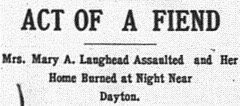I have chosen four articles to share today that span just more than 22 years with the oldest article being more than 140 years old. The articles all deal with assault or theft. I always thought that what happened here in the old days would be so different from 1878 up until today, but you will see as you read these articles that it is not true. Please pay attention, again, to the way the articles are worded as they are so creative.
The first article is from the May 22, 1878 issue of the Monroe Sentinel.
“Mr. Blutz, who keeps the liquid restaurant on Jackson street (16th Avenue), was severely assaulted by a young man by the name of Padden, last Saturday evening, at about 6 o’clock. It seems that Padden had some of Father War’s “gift of God” in him, and that made him crazy for more of the same “holy spirits,” and when Mr. Blutz told him nix, Patsy leveled his five bowers at Mr. B’s left music detector, and caused him to fall. It is stated that Herr Blutz was severely pounded by Padden before parties interfered. Constable Strawser arrested Padden and marched him off to Studley’s iron grated hotel. This Padden is the same chap that had the rumpus with the night watchman a few days ago and was let off so easy; saloon-keepers paying his fine. Padden was brought before Justice Abbott on Monday, pleaded guilty, and was sentenced to 40 days and hard work.”
I searched for information in the city directories and found there was an M. Blotz who had a saloon across from the depot in 1885. This would have been on Smokey Row as that was the only railroad track through town then. Martin Blotz was also listed as a saloonkeeper in 1889, 1891 and 1895. He was retired by 1900 and possibly rented out the building for a few years until Thomas Knight “purchased the Blotz building on Smokey Row” to open a saloon there in January 1905. F F Leibly, the previous tenant, was moving “to the next building, which will give the street two saloons.”
I found it interesting that the saloon was referred to as a “liquid restaurant,” Padden’s fingers as “five bowers,” Blotz’s ear as his “left music detector,” and the jail as the “iron grated hotel.”


The second article from the May 30 issue of the Monroe Evening Times is titled, “Act of a Fiend.”
“A dastardly assault was made upon Mrs. Mary A. Laughead, in her home a few miles east of Dayton the other night. Robbery did not seem to be the motive as there was no attempt made to carry away a considerable amount of money that was in the house. Mrs. Laughead, who is past 70 years of age, was able to get to a neighbor’s about midnight and give an alarm and soon after her house was discovered on fire and was burned to the ground. She had taken her valuables with her so that her loss is not as heavy, financially, as it would have been. The authorities are investigating the affair.”
The next article is from the Monroe Evening Times of Feb. 3, 1907.
“Mrs. Etta Rollins, who lives a mile south of Brooklyn, drove two daylight robbers out of her cellar with a rolling pin yesterday and telephoned for the police. The marauders have been lodged in jail at Janesville.”
This final article is from Dec. 12, 1900 and is labeled, “A Tramp Thief.”
“Officer Fetterhoff pulled in a smart “Willie” at the Illinois Central depot (on the north end of 17th Avenue) on Monday night, who had in his possession a lady’s overcoat, a regular “Auto-mobile” style, which he had taken from a “form” in front of J. H. Miller’s store on Monday evening. The coat was identified and the thief was locked up. Yesterday he was brought before Justice Dunwiddie, and was given six months in the county jail. From the man’s actions and appearance, he probably took the chances to get just that but maybe he won’t like the stone pile in the jail annex. The tramp made no effort to conceal the coat. When arrested, he “was carrying the garment on his arm a la mode.” He was awaiting the Madison evening train when the officer nabbed him.”
It sounds like this man might have wanted to be caught to get housed in a warm building. J. H. Miller ran a dry goods store on the northwest corner of the Square in the building that eventually became the Monroe Clinic [now the front yard of the Monroe Public Library]. There is a photograph of this Chenoweth Block on the bottom of page 11 of the Pictorial History of Monroe and on the top of page 62 in the Monroe Area Pictorial History.
— Matt Figi is a Monroe resident and a local historian. His column will appear periodically on Saturdays in the Times. He can be reached at mfigi48@tds.net or at 608-325-6503.



